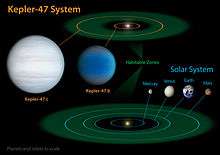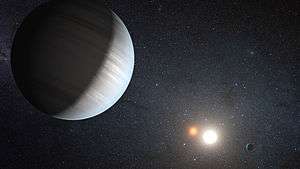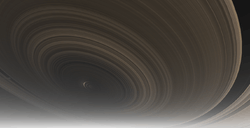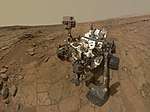Kepler-47b
Kepler-47b (also known as Kepler-47 (AB) b and by its Kepler Object of Interest designation KOI-3154.01) is an exoplanet orbiting the binary star system Kepler-47, the innermost of three such planets discovered by NASA's Kepler spacecraft. The system, also involving two other exoplanets, is located about 3,400 light-years (1,060 parsecs) away.
 This diagram compares our own solar system to Kepler-47, a double-star system containing two planets, one orbiting in the so-called "habitable zone." | |
| Discovery | |
|---|---|
| Discovered by | Kepler spacecraft |
| Discovery date | August 3, 2012[1] |
| Transit (Kepler Mission) | |
| Orbital characteristics | |
| 0.2962 (± 0.004)[2] AU | |
| Eccentricity | <0.035[2] |
| 49.532+0.04 −0.027[2] d | |
| Inclination | 89.70+0.5 −0.16[2] |
| Star | Kepler-47 (KOI-3154) |
| Physical characteristics | |
Mean radius | 3.03 (± 0.12)[2] R⊕ |
| Mass | 8.427 (± 0.62)[3] M⊕ |
| Temperature | 449 K (176 °C; 349 °F) |
Characteristics
Mass, radius and temperature
Kepler-47b is a gas giant, an exoplanet that is near the same mass and radius as the planets Jupiter and Saturn.[4] It has a temperature of 449 K (176 °C; 349 °F).[5] The planet has a radius of 3.03 R⊕, and has no solid surface.[6] It has a mass of 8.43 M⊕.
Host stars
The planet orbits in a circumbinary orbit around a (G-type) and (M-type) binary star system. The stars orbit each other about every 7.45 days.[2] The stars have masses of 1.04 M☉ and 0.35 M☉ and radii of 0.96 R☉ and 0.35 R☉, respectively.[2][1] They have temperatures of 5636 K and 3357 K.[2][1] Based on the stellar characteristics and orbital dynamics, an estimated age of 4–5 billion years for the system is possible. In comparison, the Sun is about 4.6 billion years old[7] and has a temperature of 5778 K.[8] The primary star is somewhat metal-poor, with a metallicity ([Fe/H]) of −0.25, or 56% of the solar amount.[1] The stars' luminosities (L☉) are 84% and 1% that of the Sun.[2][1]
The apparent magnitude of the system, or how bright it appears from Earth's perspective, is about 15.8. Therefore, it is too dim to be seen with the naked eye.
Discovery
Kepler-47b, as well as Kepler-47c, was first discovered by scientists, from both NASA and the Tel-Aviv University in Israel, using the Kepler space telescope.[10] Additionally, the planetary characteristics of both objects were identified by a team of astronomers at the University of Texas at Austin's McDonald observatory.[6] Both planets were discovered after transiting their parent stars, and they both seem to be orbiting along the same plane.[10]
Significance
Prior to the discovery of Kepler-47c, it was thought that binary stars with multiple planets could not exist. Gravitational issues caused by the parent stars would, it was believed, cause any circumbinary planets to either collide with each other, collide with one of the parent stars, or be flung out of orbit.[9] However, this discovery shows that multiple planets can form around binary stars, even in their habitable zones;[9] and while Kepler-47c is most likely unable to harbor life, other planets that could support life may orbit binary systems such as Kepler-47.[4]
See also
- List of extrasolar planet firsts
- List of planets discovered by the Kepler spacecraft
References
- Orosz, Jerome A.; Welsh, William F.; Carter, Joshua A.; Fabrycky, Daniel C.; Cochran, William D.; Endl, Michael; Ford, Eric B.; Haghighipour, Nader; MacQueen, Phillip J.; Mazeh, Tsevi; Sanchis-Ojeda, Roberto; Short, Donald R.; Torres, Guillermo; Agol, Eric; Buchhave, Lars A.; Doyle, Laurance R.; Isaacson, Howard; Lissauer, Jack J.; Marcy, Geoffrey W.; Shporer, Avi; Windmiller, Gur; Barclay, Thomas; Boss, Alan P.; Clarke, Bruce D.; Fortney, Jonathan; Geary, John C.; Holman, Matthew J.; Huber, Daniel; Jenkins, Jon M.; et al. (2012). "Kepler-47: A Transiting Circumbinary Multi-Planet System". Science. 337 (6101): 1511–4. arXiv:1208.5489v1. Bibcode:2012Sci...337.1511O. doi:10.1126/science.1228380. PMID 22933522.
- "Kepler-47 b". NASA Exoplanet Archive. Retrieved August 5, 2016.
- "Kepler-47". Exoplanets Data Explorer. Retrieved August 5, 2016.
- "Newfound 'Tatooine' Alien Planet Bodes Well for E.T. Search". space.com. September 4, 2012. Retrieved January 5, 2013.
- http://www.hpcf.upr.edu/~abel/phl/hec_plots/hec_orbit/hec_orbit_Kepler-47(AB)_b.png
- "Astronomers Find First Multi-Planet System Around a Binary Star". spacedaily.com. September 3, 2012. Retrieved January 5, 2013.
- Fraser Cain (16 September 2008). "How Old is the Sun?". Universe Today. Retrieved 19 February 2011.
- Fraser Cain (September 15, 2008). "Temperature of the Sun". Universe Today. Retrieved 19 February 2011.
- "Tatooine-like double-star systems can host planets". bbc.co.uk. August 29, 2012. Retrieved January 5, 2013.
- "New worlds discovered, courtesy of US-Israel team". timesorisrael.com. August 30, 2012. Retrieved January 5, 2013.



